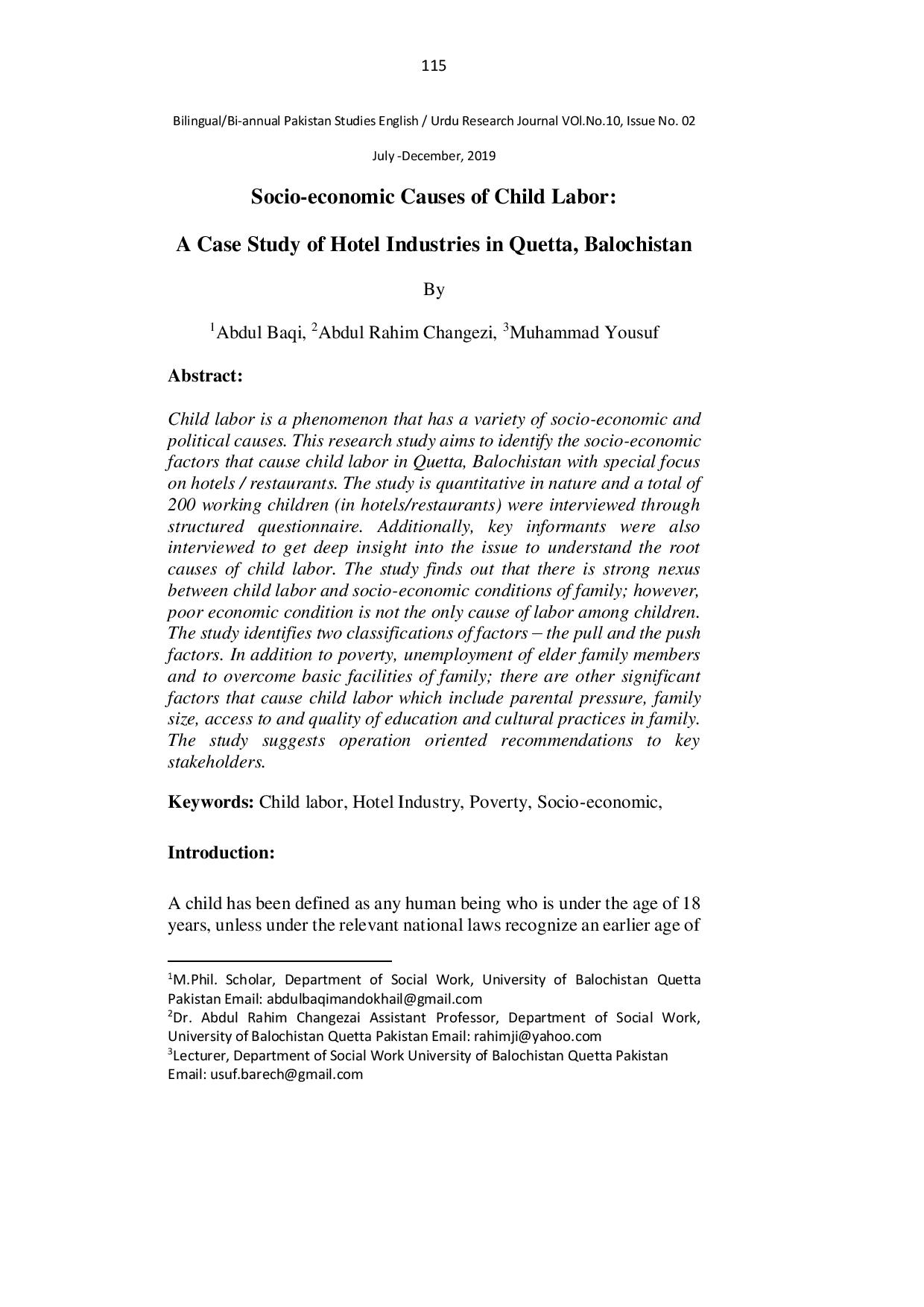Socio-economic Causes of Child Labor: A Case Study of Hotel Industries in Quetta, Balochistan
Keywords:
: Child labor, Hotel Industry, Poverty, Socio-economicAbstract
Child labor is a phenomenon that has a variety of socio-economic and
political causes. This research study aims to identify the socio-economic
factors that cause child labor in Quetta, Balochistan with special focus
on hotels / restaurants. The study is quantitative in nature and a total of
200 working children (in hotels/restaurants) were interviewed through
structured questionnaire. Additionally, key informants were also
interviewed to get deep insight into the issue to understand the root
causes of child labor. The study finds out that there is strong nexus
between child labor and socio-economic conditions of family; however,
poor economic condition is not the only cause of labor among children.
The study identifies two classifications of factors – the pull and the push
factors. In addition to poverty, unemployment of elder family members
and to overcome basic facilities of family; there are other significant
factors that cause child labor which include parental pressure, family
size, access to and quality of education and cultural practices in family.
The study suggests operation oriented recommendations to key
stakeholders.
References
Akhtar, A.H., Ambreen, F., Sadaqat, M., (2010). Socio-economic
conditions of child labour: A case study for the fishing sector
on Balochistan coast. International Journal of Social
Economics, 37 (4): 316 – 338.
Avais, A, M. Saima, s & Mirjat, J, a (2016) Socio-Economic Analysis
of Child Labor in Hyderabad City: Dept. of Sociology, etc.,
University of Sindh, Jamshoro, Pakistan:/ Volume-I, Issue-I,
February 2015, Page No. 180-185 Published by: Scholar
Publications, Karimganj, Assam, India, 788711
Ariyanti, I., (2018). Socio-economic factors affecting the child labour in
Palembang City Indonesia /politeknik Nigeri Sriwijaya
Palembang, Indonesia
Eijaz, R., (2008). Gender Analysis of Children ‘s Activities in Pakistan‖,
The Pakistan Development Review 47:2 pp. 169–195
Dessy, S. E., & Pallage, S. (2005). A Theory of the Worst Forms of
Child Labour. The Economic Journal, 115(500), 68-87
Fyfe, A. (2004), Child Labour Policy Option, ed. Kristoffel Lieten and
Ben White, Child labour and education, Revisiting the policy
debate, Aksant Academic Publishers, Cruquius weg 31, NL1090AT Amsterdam
Khan, S., (1982). Compelled child labor in Punjab: A case study’’.
Lahore: Punjab Economic Research institute
Mazhar, Z.A., (2008). Child Labour in Pakistan: Including the Excluded
Subsidized Education and Subsidy: Tools to Combat the
Worst Forms of Child Labour) The Hague, the Netherlands
Mehra, J. A., (2017). http://thebalochistanpoint.com/letter-child-laborin Balochistan: Published in The Baluchistan Point
Prouty, R., Luintra, A., Fares, J., & Betcherman, G., (2004). Child
labour, education and children’s rights:/social protection unit
human development network the World Bank. Social
protection discussion paper series
Paycheck.pk (2018) child labour in pakistan:
https://paycheck.pk/labour-laws/fair-treatment/minors-andyouth/child-labour. (accessed date. 15th Nov. 2018)
Rao, Venkateshwar, D., (2004). Child Rights – A perspective on
International and National Law, New Delhi: Manak
Publications Pvt. Ltd., p.5.
Saddat, M., (2009) A comparative study of conflicting image of child
between south Asia and Nordic countries, Faculty of social
sciences Osolo university College
Victor. (2017). https://www.importantindia.com/25558/child-labourmeaning-causes-effects-solution (accessed date: 11th Oct.
Wadgave, H. V., Godale, L. B., (2013). Why children are taking up the
job? Indian journal of community medicine: official
publication of Indian Association of Preventive & Social
Medicine, 38(2), 122.



